Erik Garrison <erik.garrison@gmail.com>
tl;dr: We implement a differentially private haplotype sampling method in a pangenomics toolkit. It projects \(\epsilon\)-differentially private synthetic pangenome variation graphs out of pangenomes built from complete haplotype-resolved assemblies like those made in the Human Pangenome project. We generate \(\epsilon\)-differentially private graphs from the human major_histocompatibility_complex (MHC), and use these to explore the effects of algorithm paramaters on output.
Building a globally inclusive pangenome
Our goal the privvg project is to enable researchers to share sequences from (pan)genomic cohorts without violating individual privacy guarantees. The release of this information can make it easier to understand the sequence of a new genome which we sequence or analyze. And, it can give us a foundational reference describing variation and evolution in humans.
In establishing a method to share sequences from private cohorts publicly, we hope to spark the development of a universal human pangenome that can be built fully in the open using material that represents the group properties of cohorts which are otherwise impossible to access.
Sharing genomic information has major social benefits
When we observe a new genome, we do so with DNA sequence reads that are much smaller than the full genome. To place them in the context of biological features, we compare them to a complete set of genomes. Our sequencing and analysis costs can be reduced dramatically if we compare the sequence reads to a reference genome, or pangenome (many genomes). A pangenome representing many individuals can show us the frequency of a given allele, which is critical in the analysis of rare genomic disease cases.
There are significant practical benefits to data sharing. But, the standard in human genomics is to not share information, as the release of genomic information can pose a major privacy risk. Some sharing does occur, for instance, many medical cohorts are able to release summary statistics about SNPs, such as their frequency. Unfortunately, this is very limited information. We would rather know frequencies of the alleles of whole genes—the functional units of the genome—which may be 10-100Kbp. Furthermore, given that the cost to build a complete de novo assembly of a human genome is rapidly dropping [nurk2022], we see a need to develop a method that lets the privacy-preserving data release that provides access to the full sequence space of the pangenome, not just point mutations relative to a reference genome.
Enabling privacy-preserving sharing with differential privacy
Large medical cohorts with associations between genomes and phenotypes usually only provide controlled data access to trusted researchers. Our goal is to establish a standard whereby a they could release a fully-public transformation of this controlled data for global use by anyone. This would thus provide global biomedical utility without significant risk to study participants. We do so by applying tools from differential privacy.
Differential privacy is an approach to data release that which allows for the description of group characteristics without revealing information about single individuals. It quantifies privacy loss caused by the release of information, allowing us to reason about the risks that a particular data sharing model poses to individual privacy. We build on decades of work on differential privacy, which has yielded well-defined models of differentially private data publication [dwork2014]. Our work is similar to approaches that have been used for trajectory data release, but differs in the unique biomedical context and properties of the graph data structures we use. This has led to the need for an application-specific implementation.
Synthetic differentially private pangenomes
Differential privacy provides tools that allow us to generate privacy-preserving synthetic databases out of real ones. We pursue this approach because we judge that it is easier to share static databases than organize access to differentially private queries. If we provide a tool to produce a differentially private synthetic pangenome, a genomics research project could release a pangenome that can be reused indefinitely by external researchers. Reuse of this database would not constitute increased privacy risk to individuals [dwork2014].
Applying the exponential mechanism
We say that a mechanism to draw synthetic database \(x\) from range \(\mathcal R\) is \(\epsilon\)-differentially private. In the abstract, this means that, if we had another neighboring synthetic database \(y\) differing from \(x\) in the exclusion of a given individual, we would expect them to differ by less than \(\epsilon\). These approaches work by adding controlled, shaped noise to the elements and contents of queries or synthetic databases generated out of private data.
To develop such a synthetic database, we have a unique situation. In contrast to tabular data, we have a sequence collection, and the sequences have been compressed into a graph [garrison2022]. Genomes are walks through this graph. Intuitively, a differentially private query of a pangenome could expose information about sequences while adding noise to the walk. However, such noise could easily destroy the value of the released data, generating nonsense haplotypes that may not be viable or have a meaningful frequency in the population.
The exponential mechanism was designed for situations like this, where we want to choose the best response for a query but adding noise directly to the computed result can utterly destroy its value. Following this approach, we’ve designed the privvg algorithm. In essence, this approach samples haplotypes from a pangenome graph (formally, a variation graph) by following a walk guided by the exponential mechanism.
The shape of the privacy-preserving pangenome graph
The exponential mechanism operates on the exponentiated utility of query results, releasing randomly sampled data elements \(\propto \exp(u)\). Exponentiation helps to provide differential privacy guarantees, while utility is a social construct that lets us define which database elements are more important.
In our context, we assume that the utility of a haplotype observation (equivalently: allele, or genomic subsequence) is the log-frequency of this sequence in the population. Intuitively, more common haplotypes are more likely to be found in other individuals. The better that these are represented in our pangenome, the better the pangenome will contain or represent a new genome. This makes them more useful. However, the incremental benefit of one high frequency allele over another is proportionally less than for lower-frequency alleles (thus, we take the logarithm of frequency). We also would like to not expose too many rare haplotypes, as they may allow for privacy-destructive attacks, so their release would decrease utility.
By guiding the exponential mechanism using haplotype frequency as utility, we will obtain a pangenome that represents group characteristics and common sequences in the pangenome. Bear in mind that "common" here might mean "shared by a few individuals", and could in fact be very rare in a fractional sense when we apply privvg to a very large cohort pangenome.
odgi: a command line analysis toolkit for pangenomics
The optimized dynamic graph interface, odgi [guarracino2022], provides a command line interface to diverse operations on pangenome graphs [eizenga2020].
It allows for transformation and dynamic construction of new graphs based on others and data associated with their embedded genome paths.
It’s designed in the style of bedtools—a well-known bioinformatic toolkit for working with positions, ranges, and alignments on genomes.
But, instead working on genomes, odgi works on pangenomes, and specifically graphs that represent them.
We developed this toolkit to support work in the Human Pangenome project, where it has provided an essential interface to the graphs we built from 44 human genomes (some 90 human haplotypes when including the two reference genomes) [liao2022].
Our previous explorations have focused on the GBWT, but in the interest of avoiding additional software dependencies and indexing steps, we decided to directly implement the method no top of the dynamic graph data structure offered by odgi.
Our plan of attack
odgi provides an ideal delivery vehicle for our research into differentially private pangenome transformations.
Previously, we developed a prototype based on the graph Burrows-Wheeler transform (GBWT).
To simplify development and application of our approach, we opted to build directly on top of the dynamic graph model in odgi.
Parameters
We take a few parameters:
e(epsilon)-
Differential privacy parameter \(\epsilon\), expressed in terms of utility, which is allele observation counts in haplotypes.
d(target-depth)-
A target depth to which we cover the graph. We continue sampling haplotypes until we collect enough sequence to achieve this coverage. A future enhancement will be to use a privacy budget to determine the total depth of sampling, rather than a target depth. In practice, we’ll probably want this depth to be lower than that of our source data.
c(min-hap-freq)-
Released haplotypes must have at least this frequency in our base grap. At least 2x is required, or we run into singularities in the exponential mechanism, where the change in utility \(\Delta u\) becomes infinite.
b(bp-target)-
A minimum length of a sampled haplotype. The sampling algorithm runs until we reach this length, at which point we emit the sampled haplotype so long as it’s at or above our minimum haplotype frequency.
Sampling algorithm
Our sampling algorithm follows a basic approach. (1) We randomly select a node, and collect all the path steps across it. (2) We bundle these paths depending on where they next go, and select a bundle using the exponential mechanism. (3) The process iterates, using the bundle of open paths, until we reach a length or frequency based stopping condition. (4) If our haplotype frequency is too low, we do not emit the haplotype. (5) If it’s high enough and our length is sufficient, we emit the haplotype and count its length towards our target.
For greater clarity, we provide it in pseudocode:
target_length := d * graph_length
sampled_length := 0
while sampled_length < target_length:
handle := get a random node and orientation
ranges := {}
# initial state
for each step on handle:
ranges.insert((step, step))
walk_length := 0
while ranges is not empty:
# determine potential next steps
nexts := map node -> {}
for range in ranges:
next_step := get_next_step(range.end)
next_handle := get_handle_of_step(next_step)
nexts[next_handle].insert((range.begin, next_step))
# compute exponential mechanism weights for extension
sum_weights := 0
weights := []
for next in nexts:
# log-frequency of the extension is utility
utility := log1p(next.size())
# sensitivity, or the effect of removing an individual on utility
delta_utility := utility - log1p(next.size()-1)
# weight for sampling
weight := exp((epsilon * utility) / (2 * delta_utility))
weights.append((weight, next))
sum_weights += weight
# use weighted random sampling to compute the next extension
sample := random_0_1() * sum_weights
x := 0
opt := null
for weight in weights:
if x + w.first >= sample:
opt := w.second
x += weight.first
# now opt is our next step, so we recurse onto it
ranges = nexts[opt]
# update our sampled length
walk_length += get_length(opt)
# and determine if we've reached a stopping point
if ranges.size() < min_hap_freq:
# our frequency is too low, violating our parameters
break
# our stopping condition
if ranges.size() >= min_hap_freq and walk_length >= bp_target:
# update our sampled length
sampled_length += walk_length
# to avoid orientation bias, we emit a randomly-sampled representative
emit_sampled_haplotype(ranges.random())The privvg algorithm lands in odgi!
We’ve implemented this algorithm in odgi! To ensure scalability, we run the sampling algorithm in parallel over the graph, with each thread accumulating samples independently. (This is currently fully random, but a future improvement will allow for deterministic sampling, which is critical for testing.) Tests on the human MHC indicate runtimes that are more than acceptable for the application to the entire draft Human Pangenome (HPRCy1) [liao2022]. The rest of this post will use this practical tool to generate synthetic differentially private pangenomes and explore their features relative to key parameters.
Exploring privvg parameters with the human MHC
To get a feeling for how the various parameters affect the shape of emitted graphs, we can work through a few tests based on one of the more interesting and diverse regions of the human pangenome: the major_histocompatibility_complex or MHC.
The idea here is to get a taste for what these key parameters can do to the synthetic differentially private haplotype set that we produce.
We’ll use tools from odgi to get access to the graph itself.
Looking at MHC pangenome graph
First, we built a graph of the MHC using the PanGenome Graph Builder, pggb.
(We collected MHC sequences as described in this short tutorial, and then built the graph using pggb -n 90 -p 90 -s 50k -k 29 with 0.3.1+237bf05.)
We download, unpack it, and build an odgi graph from it.
wget https://f004.backblazeb2.com/file/pangenome/HPRCy1/HPRCy1v2.MHC.fa.ce6f12f.e9aeea8.0ead406.smooth.final.gfa.zst
zstdcat HPRCy1v2.MHC.fa.ce6f12f.e9aeea8.0ead406.smooth.final.gfa.zst >mhc.gfa
odgi build -g mhc.gfa -o mhc.og -t 16Let’s check some basic statistics:
odgi stats -i mhc.og -S
#length nodes edges paths steps
5372615 257163 359123 126 14873189The graph is 5.37Mbp long, with 126 paths (there are 90 haplotypes, but some haplotypes have multiple contigs, each corresponding to a separate path), and 14M steps.
For diagnostics, wec an get a 1D visualization of the graph with odgi viz.
This shows us a kind of binary matrix.
Across the x-axis we have nodes in the graph.
Across the y-axis we have paths through the graph.
Each path is a specific contig, representing a part of a haplotype of a human genome.
Where we have white, the path is not crossing the given region of the graph, but where a color (based on a hash of the path name) is assigned, we can see that the path does occur.
In effect, this shows that many haplotypes cover the entire MHC.
odgi viz -i mhc.og -o mhc.png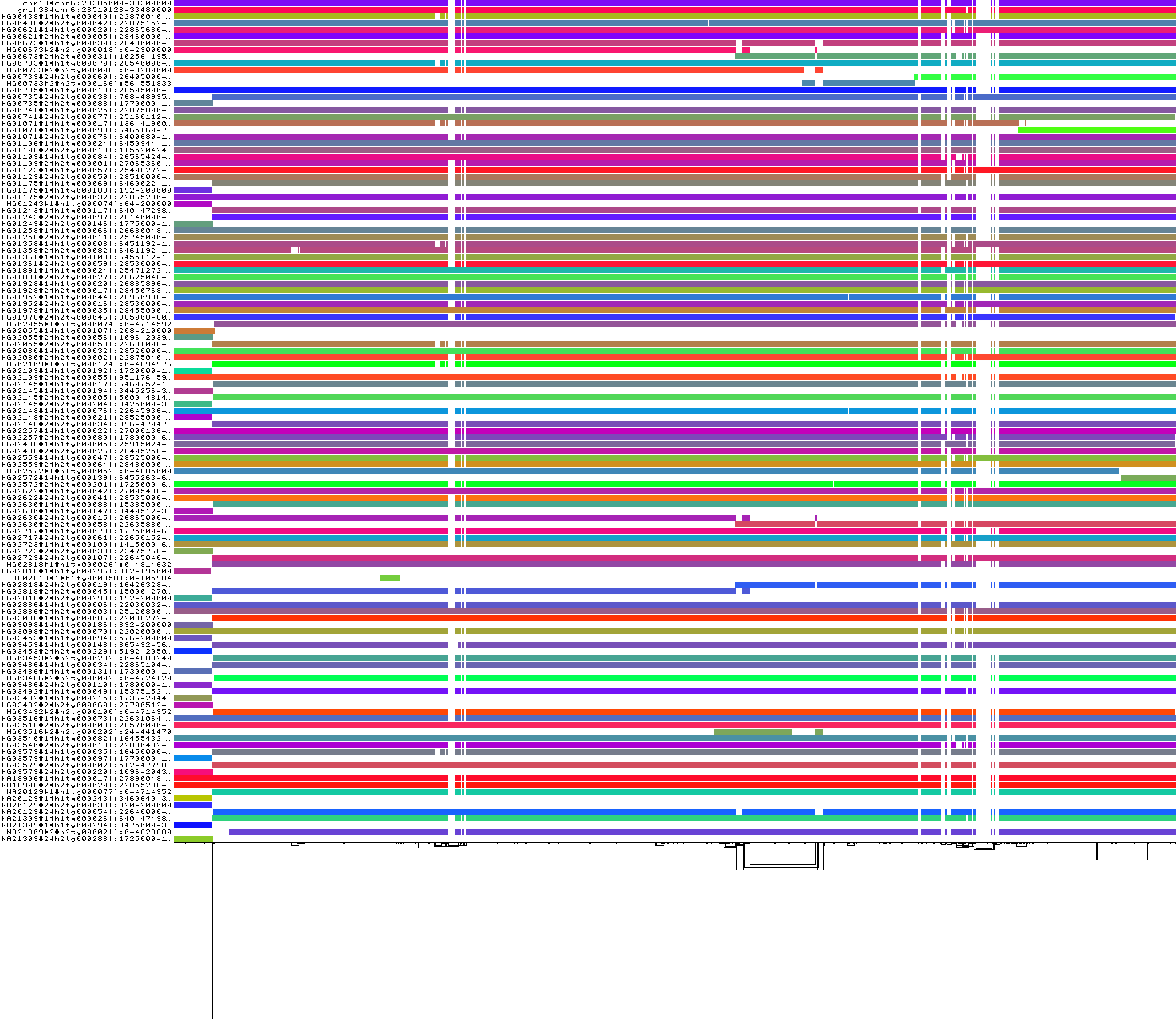
The complex region to the right side of the visualization corresponds to the MHC class II genes.
We can visualize this too, with gfaestus. The orientation and order are very similar to the above 1D visualization, letting us see how the graph looks in 2D.
odgi layout -i mhc.og -T mhc.og.lay.tsv -t 16 -P
gfaestus mhc.gfa mhc.og.lay.tsv
Here, the splines we see correspond to sequences in the graph. Each node has a specific color, leading to the rainbow patterns that we see. Each change in color thus indicates a new allele in the pangenome.
Zooming in on the MHC class II genes shows a very complex structure. This is one of the most highly-diverged regions in the human genome. Balancing selection drives diversity here, as the genes in the MHC encode for features of the immune system. It is very advantageous for the human population to not have the same alleles here, so that our response to pathogens varies and it is not easy for a single pathogen to cause illness in all people.
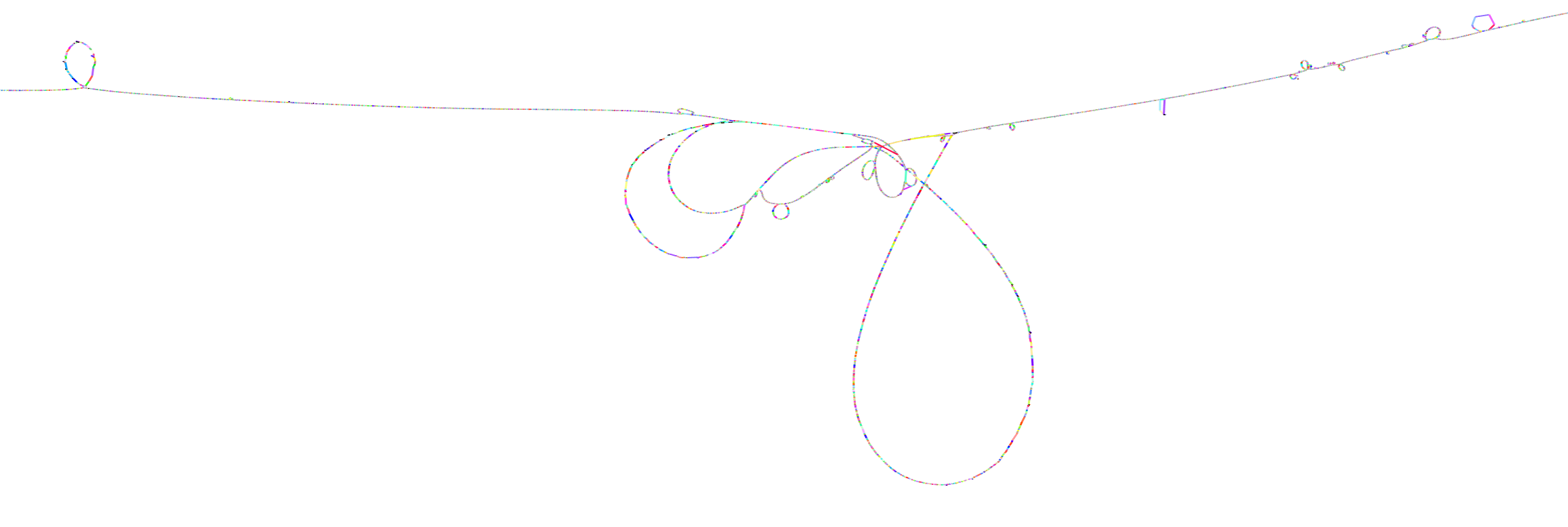
Finally, we can get a compressed mode output from odgi viz which shows us a kind of heatmap across the graph space.
For the full MHC graph, this is very boring: we have coverage almost everywhere:
odgi viz -i mhc.og -o mhc.compr.png -O
We’ll use this when making privvg transformations of the graph to get a sense of what we lose with different parameter combinations.
Applying privvg to the MHC pangenome
odgi priv provides the primary interface to apply the privvg algorithm to a graph.
Here we extract a haplotype sample of 10kbp sequences, targeting 100x total coverage, and emitting a progress message:
odgi priv -i mhc.og -o mhc_priv.og -t 16 -b 10000 -d 100 -e 0.01 -P
odgi viz -i mhc_priv.og -o x.png -O
odgi stats -i mhc_priv.og -S#length nodes edges paths steps
5372615 257163 292605 53012 19374084We see that there are ~53k paths in the graph with a similar step count to our input graph, so the paths are much more fragmented. The compressed mode heatmap is very similar to our full graph.

Let’s try to get longer haplotypes, say 50kbp.
odgi priv -i mhc.og -o mhc_priv.og -t 16 -b 50000 -d 100 -e 0.01 -P
odgi viz -i mhc_priv.og -o x.png -O
And 100kbp:
odgi priv -i mhc.og -o mhc_priv.og -t 16 -b 100000 -d 100 -e 0.01 -P
odgi viz -i mhc_priv.og -o x.png -O
Huge holes have shown up in the view!
This means that there are parts of the graph which we were not able to sample.
The cause is straightforward: these regions do not contain any exactly shared haplotypes of 100kbp.
Thus, our haplotype frequency filter odgi priv -c 2 is preventing us from seeing any of them.
This indicates that for us to obtain a differentially private synthetic pangenome with very long haplotypes across the MHC, we will need to have many more individuals in the input pangenome.
With more individuals, we would expect a higher chance that a group of them has the exact same haplotype across one of these dropout loci.
Of course, haplotypes of even 10kbp are very useful. And for practical purposes, even 1kbp is a reasonable length for many downstream analyses. The practical utility of a differentially private pangenome is high in the MHC, so long as we can sample shorter haplotypes. The MHC represents one of the most extreme cases in the pangenome in terms of diversity and low rates of haplotype identity. This suggests that it should be straightforward to build a differentially private pangenome from the draft human pangenome!
What about \(\epsilon\)?
One parameter defines how noisy our transformation is: \(\epsilon\). A low \(\epsilon\) is likely to be private, but we may introduce too much noise for the database to be useful. So we want to consider changing this parameter and looking at its effect on the output.
When \(\epsilon\) is small, it means that it is difficult for an adversary to distinguish, for pairs of adjacent databases, the database which includes or does not include an individual. In other words, \(\epsilon\) defines the degree of noise, noisy sampling, or blurring that is added to differentially private queries or synthetic databases. When the amount of noise is large (when \(\epsilon\) is small), it overwhelms the effects of addition or subtraction of a single individual, thus making it impossible for the adversary to distinguish individuals in general [dwork2014].
Let’s sweep \(\epsilon\) and look at a population genetic parameter of the output graph, the allele frequency.
In our graphs, allele frequency is equivalent to path depth over nodes (which in the pangenome variation graph are sequences, which are equivalent to alleles).
We can extract it with odgi depth -d and plot it with R.
for e in 0.001 0.01 0.1 1;
do
odgi priv -i mhc.og -o - -t 16 -b 10000 -d 100 -e $e -P \
| odgi depth -i - -d >mhc.e$e.tsv && \
Rscript -e 'x <- read.delim("'mhc.e$e.tsv'"); require(tidyverse); ggplot(subset(x,depth.uniq>0), aes(x=depth.uniq)) + geom_histogram(binwidth=1) + xlim(0,200); ggsave("'mhc.e$e.tsv.hist.png'", height=3, width=9)'
doneThe input allele/node frequency spectrum shows a sharp peak at ~90, which is the number of haplotypes in the pangenome.

But we do not see a similar pattern in a 100x-sampled privvg when using a small \(\epsilon = 0.001\). We actually see a rather flat frequency distribution, which hides the peaks seen in the real data:
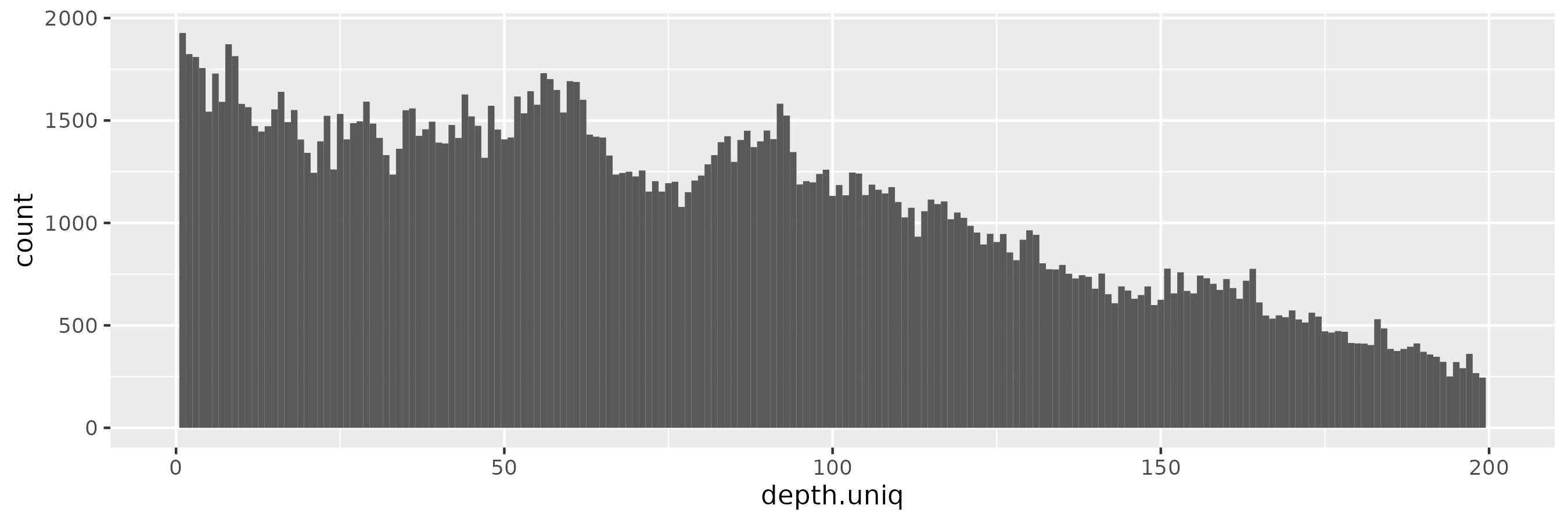
The pattern is similar for \(\epsilon = 0.01\):
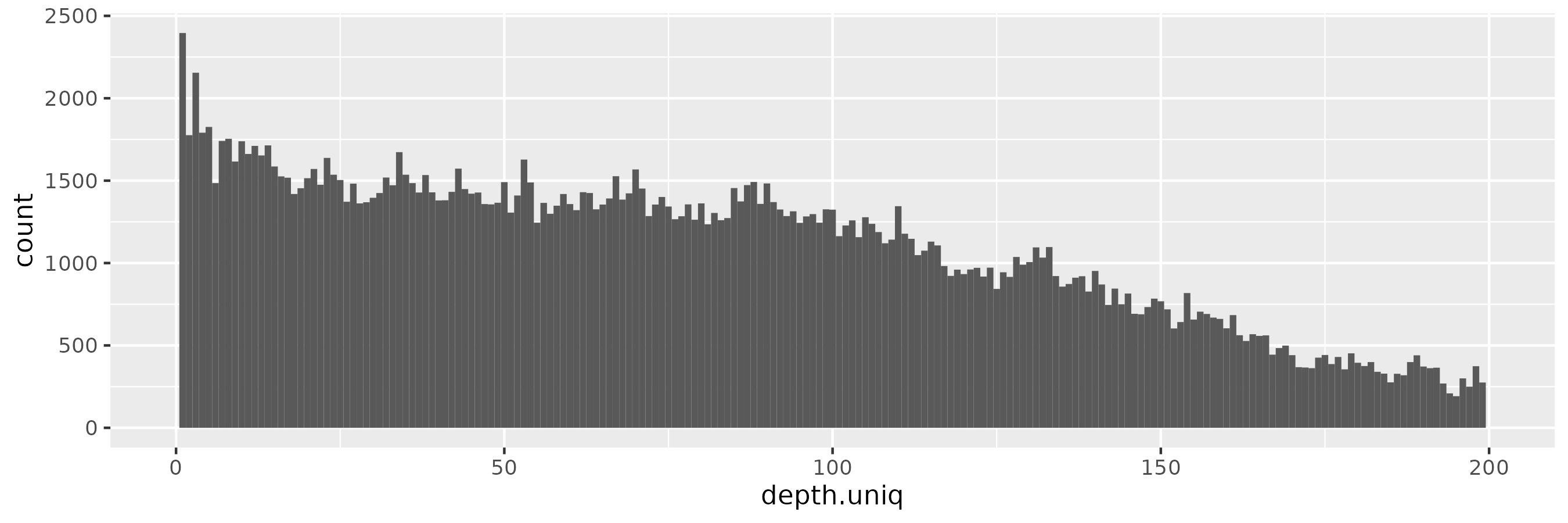
At \(\epsilon = 0.1\), we start to observe more low-frequency alleles, consistent with a more relaxed privacy guarantee:
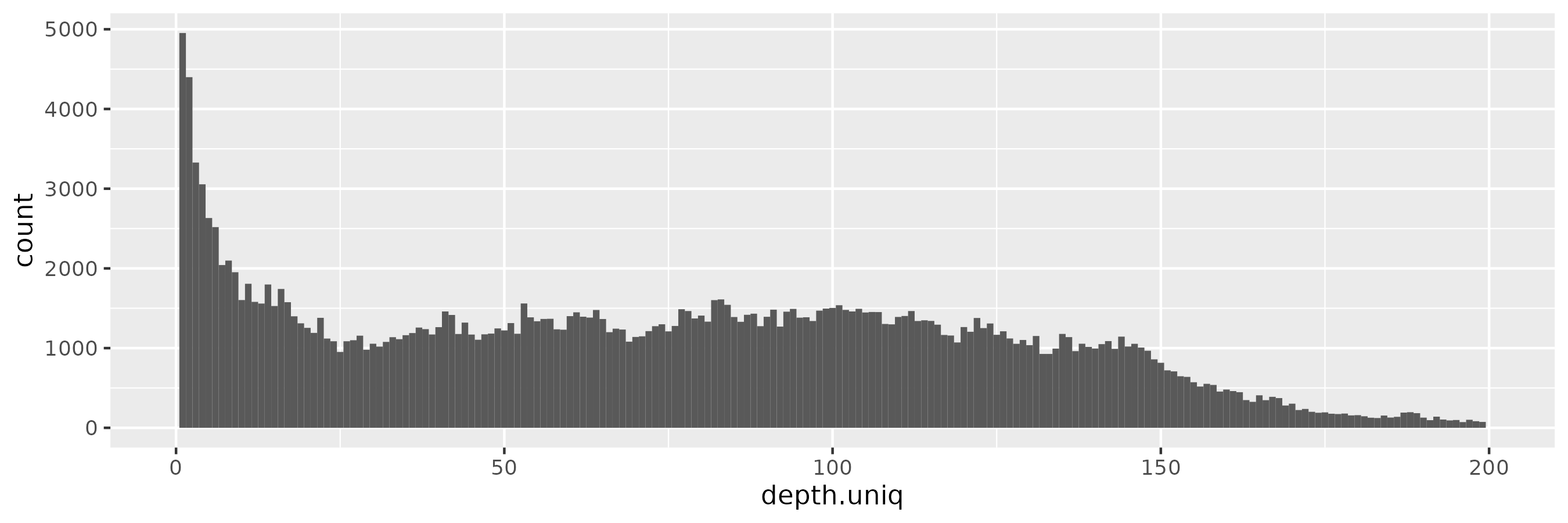
And with \(\epsilon = 1\), we begin to see a peak around the target depth (100x):
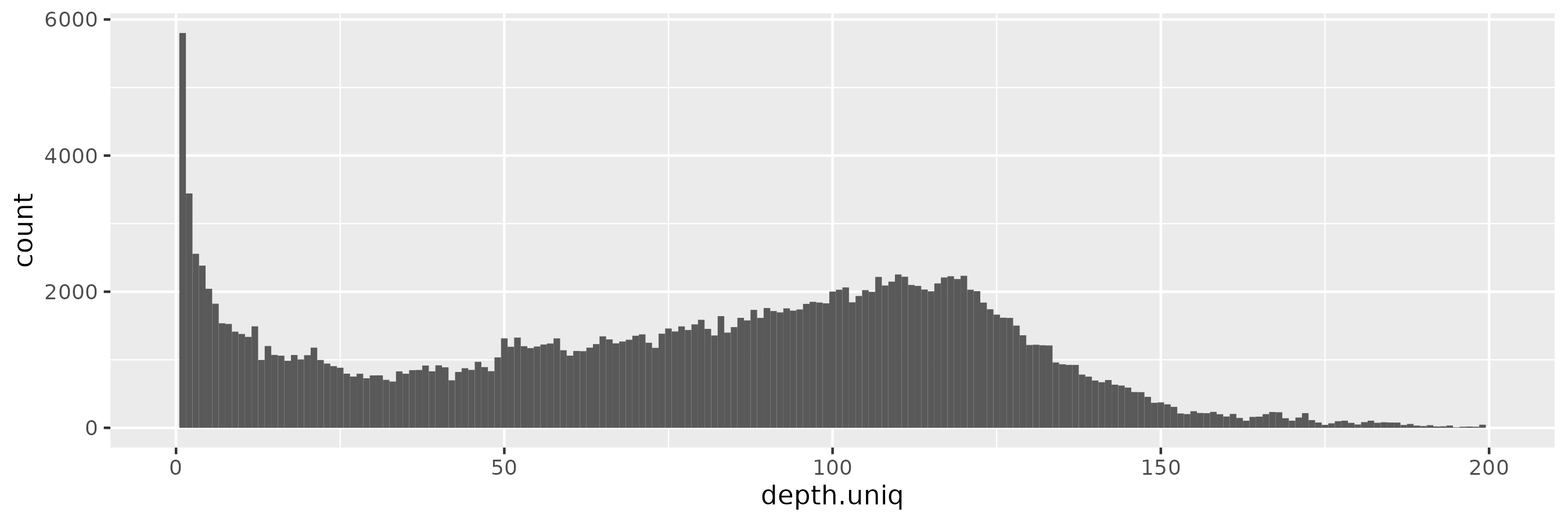
This becomes progressively more prononced as we increase \(\epsilon = 10\):
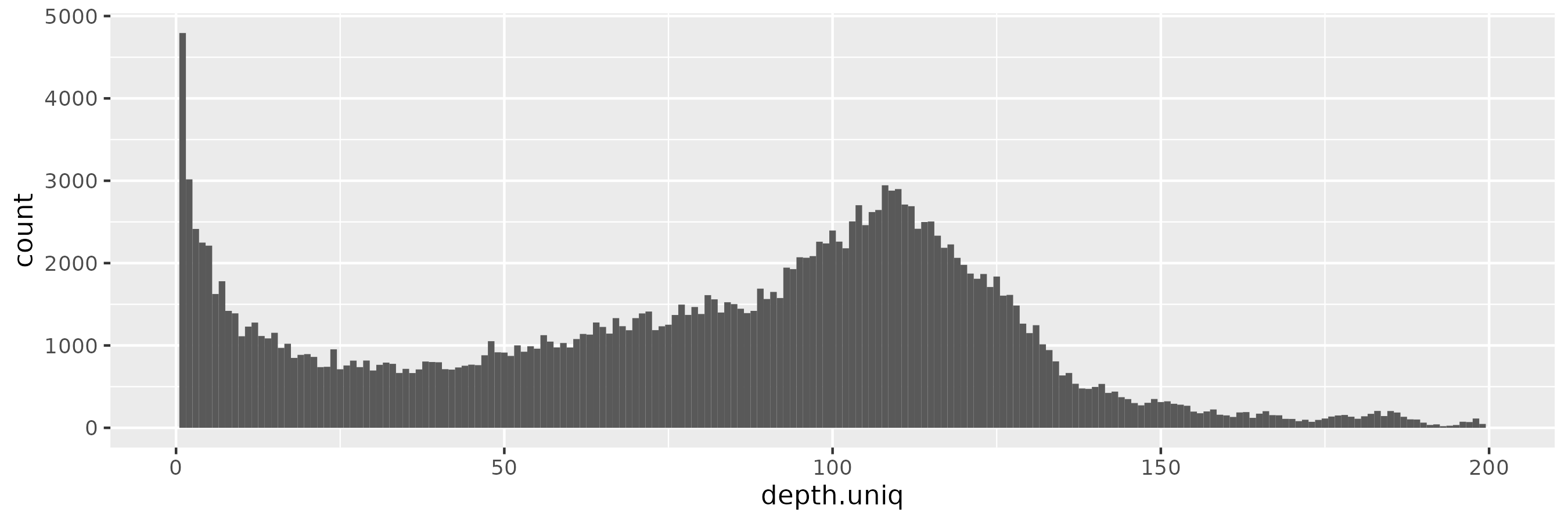
And for \(\epsilon = 100\), the pattern is starting to be reminiscient of the kind of distribution we saw in the input data, with the peak near 100x rather than 90x of course:
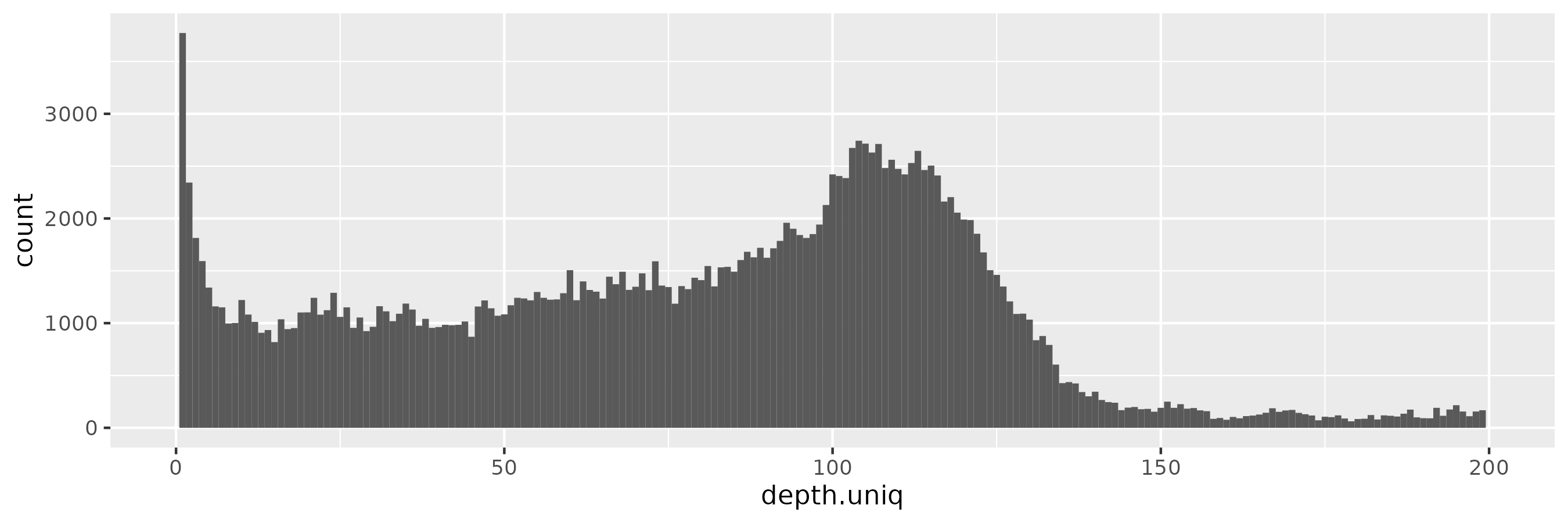
The effect of changing \(\epsilon\)
By increasing \(\epsilon\) we are exponentially down-weighting rare haplotypes.
We don’t follow them because the weight of a given option, \(\exp(\epsilon u(x, r) / \Delta u)\), becomes exponentially larger with higher utility (a.k.a. log1p(haplotype_frequency)).
In effect, we often run down the graph sampling the major allele at every site.
The sampled haplotypes can become very long and uniform in length, because they tend to always match our minimum frequency threshold requirements and run to our target length.
At the same time, when increasing \(\epsilon\), we observe an increase in rare alleles in the privvg synthetic pangenome. This pattern is consistent with a reduction in differential privacy guarantees. Rare alleles support the identification of individuals.
These patterns gives the impression that \(\epsilon\) is behaving as expected, although it’s worth noting that the interaction between our utility function and privacy is also somewhat confusing. We will already tend to over-weight common haplotypes due to them having greater utility by our definition.
Consclusions and next steps
We’ve provided a practical first implementation of differential privacy on pangenome graphs. Our approach is simple and largely follows standard concepts from the differential privacy literature, but the unique application context has made its development require a substantial amount of study.
Although we have demonstrated that our implementation in odgi priv follows expected behavior with respect to several key parameters, further evaluation will be required to ascertain the degree to which it provides the desired differential privacy behavior.
Final deliverables
We plan to close the project with two final deliverables that build on our implementation.
First, we will develop a privvg model from the HPRCy1 draft pangenome.
We will apply methods like the assembled genomes compressor agc to measure the effect of different parameters on the whole pangenome behavior of privvg.
Because the HPRC is fully public, the utility of this resource is merely research-related, but it will be the first attempt to build such a model for a whole collection of completely assembled genomes.
Second, we will establish a set of synthetic "pangenome pairs", where we add and remove specific individuals. We will present these as a public competition, with a nominal prize for anyone who is able to determine which individuals have been removed from which pangenome model. By soliciting empirically-driven responses and workflows that describe the privacy-adversarial attacks, we will build practice around the problem of differential privacy on pangenomes. In effect, this will attach a bounty on the quality of our approach, initating a long-running audit that will establish the practical foundation for applying privvg to real cohort data.
Funding
This project has been funded through the NGI0 Discovery Fund, a fund established by NLnet with financial support from the European Commission’s Next Generation Internet programme, under the aegis of DG Communications Networks, Content and Technology under grant agreement No 825322.
References
-
[dwork2014] Dwork, Cynthia, and Aaron Roth. 2014. “The Algorithmic Foundations of Differential Privacy.” Foundations and Trends in Theoretical Computer Science 9 (3–4): 211–407. https://privacytools.seas.harvard.edu/files/privacytools/files/the_algorithmic_foundations_of_differential_privacy_0.pdf
-
[guarracino2022] Guarracino, Andrea, Simon Heumos, Sven Nahnsen, Pjotr Prins, and Erik Garrison. 2022. “ODGI: Understanding Pangenome Graphs.” Bioinformatics , May. https://doi.org/10.1093/bioinformatics/btac308.
-
[eizenga2020] Eizenga, Jordan M., Adam M. Novak, Jonas A. Sibbesen, Simon Heumos, Ali Ghaffaari, Glenn Hickey, Xian Chang, et al. 2020. “Pangenome Graphs.” Annual Review of Genomics and Human Genetics 21 (August): 139–62. http://dx.doi.org/10.1146/annurev-genom-120219-080406
-
[liao2022] Liao, Wen-Wei, Mobin Asri, Jana Ebler, Daniel Doerr, Marina Haukness, Glenn Hickey, Shuangjia Lu, et al. 2022. “A Draft Human Pangenome Reference.” bioRxiv. https://doi.org/10.1101/2022.07.09.499321.
-
[garrison2022] Garrison, Erik, and Andrea Guarracino. 2022. “Unbiased Pangenome Graphs.” bioRxiv. https://doi.org/10.1101/2022.02.14.480413.